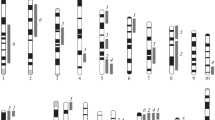Abstract
The response to selection for open-field activity in each of six lines of mice (two selected for high activity, two selected for low activity and two controls) is presented. Change in activity as a function of selection during the last five generations was found to be somewhat less than that during the first five generations, although the correlated response in open-field defecation has continued. The realized heritability of open-field activity was estimated to be 0.13±.02 and the realized genetic correlation between open-field activity and defecation was −0.80±.13.
During the tenth generation of selection, second litters were obtained so that full-sibs ofS 10 subjects could be tested in an extensive activity battery and thus assessed for the situational generality of the response to selection. In general, selection for open-field activity has produced lines which differ markedly in both activity and defecation in apparatus which have some elements in common with the open field. Apparatus which result in significant differences between the high-and low-active lines are boxlike and illuminated, but do not necessarily possess the “openness” of the open field. However, significant differences were not observed in more confining apparatus nor in exercise wheels.
Résumé
On présente les résultats d'une sélection pour activité dans un espace ouvert pour chacune des six races de souris (deux races sélectionnées pour leur niveau élevé d'activité, deux pour leur niveau bas d'activité et deux races “controles.”)
Pendant les cinq premières générations l'activité changait en fonction de la sélection plus que dans les dernières cinq générations, quoique la défécation en espace ouverte, qui est liée a l'activités continuât d'augmenter.
L' “héritabilité réaliseé” de l'activité en espace ouvert fut estimeé à 0.13±.02 et la corrélation génétique réaliseé entre l'activité en espace ouvert et la défécation était −0.80±.13.
A la dixième génération de séléction on a obténu des littlères secondes de sorte que des “full sibs” des sourisS 10 peuvaient être examinés avec une batterie extensive de mesures d'activité pour voir la généralité de sélection dans toutes les situations.
Généralement la sélection pour activité en espace ouvert a produit des races qui différent beaucoup quant à leur activité et leur défécation quand ils sont dans des appareils qui ont des éléments semblables à l'appareil “espace ouvert”.
Des appareils qui mènent à certaines différences significatives entre les races d'activité élevée et basse sont semblables à une boite et sont illuminés mais ne possèdent pas la qualité d' “ouverture” de l'appareil “espace ouvert”. Cependant aucune différence significative ne fut observée dans des appareils plus confinants ou dans des roues d'exercise.
Zusammenfassung
Resultate der Selektion für Aktivität im offenen Raumet werden dargestellt von Maüsen in jedem von sechs Stämmen (zwei selektiert für hohe und zwei für niedrige Aktivitätsniveauen, und zwei Kontrollinien) Die Änderung der Aktivität als Funktion der Selektion in den letzten fünf Generationen war kleiner als die der ersten fünf Generationen, obgleich die korrelierte Response der Defekation im offenen Raum anhielt. Die realisierte Heritabilität von Aktivität im offenem Raum wurde auf 0.13±.02 geschätzt und die realisierte genetische Korrelation zwischen Aktivität im offenen Raum und Defekation war −0.80±.13.
Während der zehnten Generation der Selektion wurden zweite Würfe gewonnen damit Vollgeschwister derS 10 Mäusen mit einer grossen Batterie von Aktivitätmäszen undersucht und so die Allgemeinheit des Selektion responses in verschiedene Situationen geschätzt werden konnte.
Im Allgemeinen hat die Selektion für Aktivität im offenen Raume Linien produziert die für Aktivität sowie für Defekation in Apparaten die einige Elemente mit dem offenen Raum Apparat gemeinsam haben, ziemlich verschieden waren. Aparate die signifikante Unterschiede zwischen den Mäusen mit viel und wenig Aktivität produzierten waren schachtelartig und beleuchtet, aber hatten nicht den “offenen” Charakter des offenen Raum Apparates.
Signifikante Unterschiede wurden weder in Apparaten die mehr begrenzt waren weder im Übungsrad beobachtet.
Similar content being viewed by others
References
Broadhurst, P. L. 1960. Experiments in psychogenetics. Applications of biometrical genetics to the inheritance of behaviour. InExperiments in personality, Vol. 1,Psychogenetics and psychopharmacology, ed. H. J. Eysenck. London: Routledge & Kegan Paul, pp. 1–102.
Broadhurst, P. L. 1969. Psychogenetics of emotionality in the rat. InExperimental approaches to the study of emotional behavior. Annals N. Y. Acad. Sci. 159: 806–824.
DeFries, J. C. 1969. Pleiotropic effects of albinism on open-field behaviour in mice.Nature 221:65–6.
DeFries, J. C., & Hegmann, J. P. 1970. Genetic analysis of open-field behavior. InContributions to behavior-genetic analysis: The mouse as a prototype, ed. G. Lindzey, & D. D. Thiessen. New York: Appleton-Century-Crofts, pp. 23–56.
Eysenck, H. J., & Broadhurst, P. L. 1964. Experiments with animals: Introduction. InExperiments in motivation, ed. by H. J. Eysenck. New York: The Macmillan Co., pp. 285–91.
Hall, C. S. 1934. Emotional behavior in the rat. I. Defecation and urination as measures of individual differences in emotionality.J. comp. Psychol. 18: 385–403.
Mather, K., & Harrison, B. J. 1949. The manifold effect of selection.Heredity 3:1–52; 131–62.
McClearn, G. E., Wilson, J. R., & Meredith, W. 1970. The use of isogenic and heterogenic mouse stocks in behavioral research. InContributions to behavior-genetic analysis: The mouse as a prototype, ed. G. Lindzey, & D. D. Thiessen. New York: Appleton-Century-Crofts, pp. 3–22.
Whitney, G. D. 1970. Timidity and fearfulness of laboratory mice: An illustration of problems in animal temperament.Behav. Genet. 1:77–85.
Winer, B. J. 1962.Statistical principles in experimental design. New York: McGraw-Hill.
Author information
Authors and Affiliations
Additional information
This research was supported in part by Research Grant GM-14547 from the National Institute of General Medical Sciences. We thank E. A. Thomas, T. W. Klein, J. Howard, and Misses Barbara Johnson and Dianne Ross for their assistance.
Rights and permissions
About this article
Cite this article
DeFries, J.C., Wilson, J.R. & McClearn, G.E. Open-field behavior in mice: Selection response and situational generality. Behav Genet 1, 195–211 (1970). https://doi.org/10.1007/BF01074652
Received:
Issue Date:
DOI: https://doi.org/10.1007/BF01074652




